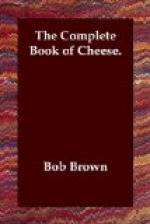Serve on toasted, buttered corn bread.
Danish Rabbit
1 quart warm milk 2 cups grated cheese
Stir together to boiling
point and pour over piping-hot toast in
heated bowl. This
is an esteemed breakfast dish in north Denmark.
As in all Rabbits, more or less cheese may be used, to taste.
Easy English Rabbit
Soak bread slices in hot beer. Melt thin slices of cheese with butter in iron frying pan, stir in a few spoonfuls of beer and a bit of prepared mustard. When smoothly melted, pour over the piping-hot, beer-soaked toast.
[Illustration]
Chapter Six
The Fondue
There is a conspiracy among the dictionary makers to take the heart out of the Fondue. Webster makes it seem no better than a collapsed souffle, with his definition:
Fondue. Also, erroneously,
fondu. A dish made of melted
cheese, butter, eggs,
and, often, milk and bread crumbs.
Thorndike-Barnhart further demotes this dish, that for centuries has been one of the world’s greatest, to “a combination of melted cheese, eggs and butter” and explains that the name comes from the French fondre, meaning melt. The latest snub is delivered by the up-to-date Cook’s Quiz compiled by TV culinary experts:
A baked dish with eggs, cheese, butter, milk and bread crumbs.
A baked dish, indeed! Yet the Fondue has added to the gaiety and inebriety of nations, if not of dictionaries. It has commanded the respect of the culinary great. Savarin, Boulestin, Andre Simon, all have hailed its heavenly consistency, all have been regaled with its creamy, nay velvety, smoothness.
A touch of garlic, a dash of kirsch, fresh ground black pepper, nutmeg, black pearl truffles of Bugey, red cayenne pepper, the luscious gravy of roast turkey—such little matters help to make an authentic dunking Fondue, not a baked Fondue, mind you. Jean-Anthelme Brillat-Savarin a century and a half ago brought the original “receipt” with him and spread it around with characteristic generosity during the two years of his exile in New York after the French Revolution. In his monumental Physiologie du Gout he records an incident that occurred in 1795:
Whilst passing through Boston ... I taught the restaurant-keeper Julien to make a Fondue, or eggs cooked with cheese. This dish, a novelty to the Americans, became so much the rage, that he (Julien) felt himself obliged, by way of thanks, to send me to New York the rump of one of those pretty little roebucks that are brought from Canada in winter, and which was declared exquisite by the chosen committee whom I convoked for the occasion.
As the great French gourmet, Savarin was born on the Swiss border (at Belley, in the fertile Province of Bugey, where Gertrude Stein later had a summer home), he no doubt ate Gruyere three times a day, as is the custom in Switzerland and adjacent parts. He sets down the recipe just as he got it from its Swiss source, the papers of Monsieur Trolliet, in the neighboring Canton of Berne:




